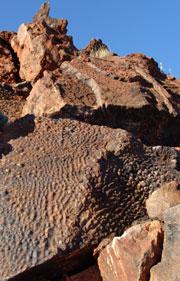 The 3.4-billion-year-old rocks show the dappled hallmarks of ancient life.Click here to see pictures of the stromatolites.Credit: A. Allwood
The 3.4-billion-year-old rocks show the dappled hallmarks of ancient life.Click here to see pictures of the stromatolites.Credit: A. AllwoodResearchers studying rock formations shaped by the earliest life on Earth have found that they harboured a plethora of different microbes. The rocks, widely regarded as some of the oldest fossils, are evidence of a 'microbial reef' ecosystem of similar complexity to modern coral reefs, the scientists say.
Geologists have been divided over whether the rock formations, called stromatolites, found in the Strelley Pool Chert in Western Australia's Pilbara region, were formed by living organisms.
The rocks bear stippled, wavy markings that many claim are the hallmarks of colonies of ancient microbes. But others argue that the formations, which are more than 3.4 billion years old, are too old to have been made by life, which is thought only to have arisen only a few hundred million years earlier.
“Life was not just getting a toe-hold [at this time] - it was well established.”
Abigail Allwood,
Macquarie University, Sydney
New studies of the Strelley Pool stromatolites suggest that they were shaped by living organisms, says Abigail Allwood of Macquarie University in Sydney, who led the research. "Life was not just getting a toehold at this time — it was well established," she says.
The variety of different markings on the stromatolites suggests that many different types of microbe were living there, the team report in this week's Nature1. And if life could diversify so soon, the researchers speculate, then maybe it could also have flourished on hostile worlds such as Mars.
Microbial menagerie
Allwood and her colleagues sampled the rocks along a 10-kilometre line, and found evidence of seven different formations, including waves, ridges and egg-carton shapes — indicating the presence of a range of different primitive organisms.
Most striking are cone-shaped formations that could not have been formed by any known geological process, she says. Instead, Allwood suggests that they must have been made by threadlike organisms gliding over one another to move towards sunlight. Mineral deposits picked up along the way would have eventually produced the rocky cones.
The Strelley Pool stromatolites are thought to be the remains of an ancient rocky shoreline. The organisms would have lived in shallow, sunny waters, Allwood says.
Life on Mars
ADVERTISEMENT
Although the discovery does not push back the date for the earliest evidence of life, the range of different structures suggests that diversity can arise more quickly than biologists had previously thought, Allwood argues.
That might even suggest that life on other planets is more likely, she adds: "If Mars was habitable only for a short time, life still could have arisen."
Conditions on Earth and Mars 3.4 billion years ago are thought to have been broadly similar, with both featuring liquid water and an atmosphere made mostly of carbon dioxide. "Since life appeared on Earth under these conditions it is certainly legitimate to speculate that it may have evolved on Mars as well, " says Ian Crawford, a planetary scientist at Birkbeck College in London.
"Only future exploration of Mars will determine whether or not it did so," he adds. "Searching for ancient stromatolite-like structures should certainly be high on the list of future exploration strategies."
Click here to see pictures of the stromatolites.
Visit our ecosystemsarrived_ear.html">newsblog to read and post comments about this story.
Macquarie University, Sydney
